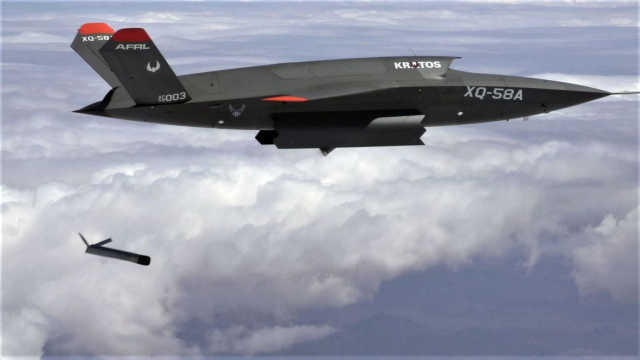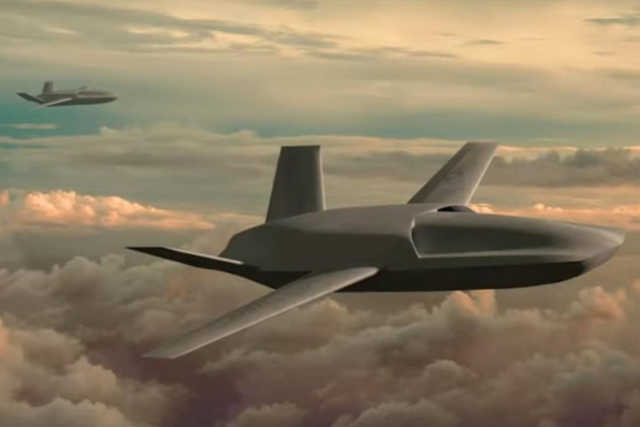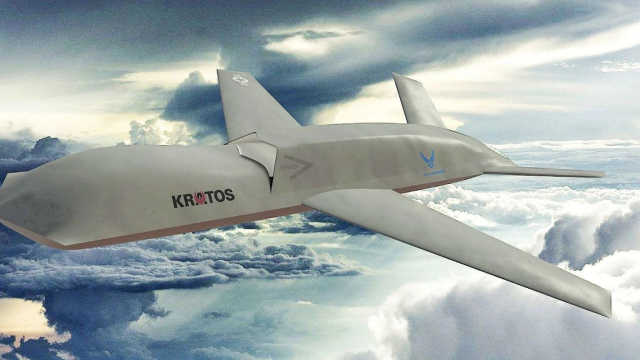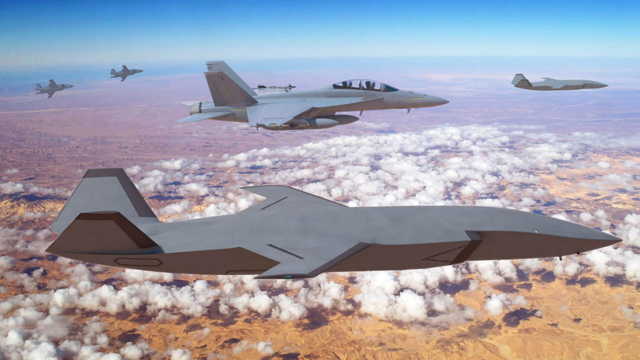With this publication we open a new topical topic of modern military research. Your attention is invited to an article recently published by the British resource shephardmedia.com . In his work "How faithful wingmen can improve the actions of next-generation fighters", the author, Gordon Arthur, consistently analyzes the state of affairs and the prospects for the implementation of the idea of joint combat use of manned aircraft and UAVs. [In the text of the note IVi are taken in square brackets]No country has adopted an aircraft with the function of a combat faithful wingman, but many are vigorously implementing this idea.
But what is a faithful wingman, an auxiliary aircraft, a long-range aircraft carrier or a pilot's friend?
To provide lexicological clarity, we asked Douglas Barrie, Senior Researcher on Military Aerospace at IISS [The International Institute for Strategic Studies], which defined them as "a class of uninhabited systems that are originally designed to work in conjunction with a manned platform."However, auxiliary aircraft may differ in how closely they are tied to the platform with the crew and how automated they are.
There is also the question of how much the drone is consumed. At the lowest end of the scale, this may be little more than a decoy that is expected to be lost in combat, while at the other end are full-scale UAVs providing substantial support to their partner manned aircraft.
What can faithful wingmen do? D. Barry listed many missions, such as reconnaissance, false targets, jamming and suppression of enemy air defenses. They can also deliver weapons, although the expert believes that the air-to-air role is "a little more complicated simply because of the difficult situation and rules of engagement." It is expected that such devices will "work in several pieces, maybe in twos or threes."
Quantity versus quality, quantity sometimes has quality in itself, and faithful wingmen succeed in this.
"It's the ability to generate combat mass, potentially at an affordable price, and in a way that you can accept a level of loss and attrition that you could never accept with a combat aircraft," D. Barry said. Auxiliary devices allow you to place more targets of different difficulty levels in the sky, which gives opponents more targets to hit.
Especially as combat aircraft crews become more expensive and pilot training is excruciatingly expensive, the Air Force feels that a loyal wingman can be one of the solutions to create combat mass.
A representative of Kratos Defense agreed with this. "The key is in the mass [quantity]. In a conflict environment, if the approach is to send a mass of UAVs with some level of threat, even if it varies depending on the number of UAVs, then defensive systems face a problem. These considerations include a balance of capabilities and costs, in which it is required to maximize the survivability of each UAV to the limit in the cost curve, and then determine the mass of the UAV needed for a specific mission/goal.""The option of maintaining an exquisite manned aircraft in a "high survivability" position is incredibly valuable from a cost point of view and critical from the point of view of human life.
The introduction of the faithful slave capability is a real game changer."The trend towards the use of single-seat fighters is partly due to a reduction in training costs.
D. Barry, however, pointed out that if the number of loyal wingmen increases, then weapons system officers will be needed in the rear of the fighters to oversee several loyal wingmen. Gradually, this will create a trend back towards mixing single and two-seat aircraft.
An alternative approach is to have most of the mission profile pre-programmed with almost completely autonomous loyal wingmen before takeoff. However, this raises questions of international law when a person's permission is required for the use of weapons.

The turbojet engine gives the XQ-58A Valkyrie from Kratos Defense a cruising speed of Mach 0.72 and a range of 3,000 nautical miles. During the sixth flight test, he launched an ALTIUS-600 UAV from his weapons compartment. (Photo: US Air Force)American efforts It is not surprising that the US is actively experimenting.
Secretary of the Air Force Frank Kendall said in December 2021 that the US Air Force is ready to go beyond experiments. "We're going to take some time to sort it all out, and then we're going to do something that we're going to put on the field. It's a commitment to move forward in a direction that we've thought about and experimented with, but weren't committed to before."He said the US Air Force wanted to "operate unmanned combat aircraft in the fighter category," such as the Next-Generation Air Dominance (NGAD) fighter, which is due to replace the F-22A in the 2030s.
"The idea here is that you have one or several — I would say nominally up to five — unmanned combat vehicles controlled by one modern manned aircraft. Basically we're looking at NGAD, but you can also do it, potentially, with an F-22 or an F-35."This screenshot from a commercial released by General Atomics gives a conceptual idea of what its Gambit, a contender for the U.S. Air Force's OBSS program, looks like.

(Image: GA-ASI)The US Air Force is also developing a "bomber partner" for the B-21. "The B-21 is a very expensive aircraft.
It has a certain carrying capacity and flight range. We would like to strengthen this ability… We need something that can work with him. I wouldn't say "accompany him" necessarily. Tactics have yet to be determined. We're not going to say much more publicly about what we're going to do. We don't want to give our potential opponents a head start on this issue," F. shared.Kendall.
One of the driving forces of American programs, especially for the Indo-Pacific theater, may be long-range operations. If the US is considering the possibility of deploying domestic weapons, then this will require large platforms.
The Air Force Research Laboratory funds the high-priority Skyborg program. According to the Ministry of Defense, it will deliver "prototypes to support operational experiments and develop the first Skyborg aerial platform with a modular hardware and software payload, which will include the basic Skyborg autonomy system and will allow combining manned and unmanned aerial vehicles."
In December 2020, two-year contracts for flight experiments were signed with Kratos Defense ($37.8 million), Boeing ($25.7 million). US$) and General Atomics Aeronautical Systems (GA-ASI) (US$ 14.3 million).
Kratos has developed the XQ-58A Valkyrie and UTAP-22 Mako. The latter is based on the Kratos BQM-167A aerial target. Valkyrie made its maiden flight on March 5, 2019, and Kratos said they were optimizing the production line to vary performance without significantly affecting costs or labor.
Further commented: "In terms of system evolution capabilities, we continued to integrate various combinations of subsystems to obtain several categories of mission performance capabilities. In general, they range from reconnaissance sensors to weapons-type payloads, sub-UAVs and barrage ammunition, as well as on-board relay capabilities."The fundamental advantages of Valkyrie are: "low cost-performance ratio; high survivability potential in contested environments; flight characteristics similar to a typical fighter in the high subsonic range, which easily adapts the device to the operations of MUM-T [manned-unmanned group /manned-unmanned teaming]; autonomy and flexibility based on open interfaces; and, finally, the flexibility [to having] a runway, which means it can take off and land without a runway."
This is an artistic rendering of the Kratos Defense candidate for participation in the USAF OBSS program.

Little is known about the design of the loyal slave. (Image: Kratos Defense)The US Air Force has another demonstration flight program, an unmanned sensor station [Off-Board Sensing Station, OBSS], within which a search is underway for an easily controlled UAV with high autonomy, whose overall architecture will allow for the rapid development of future options.
In October 2021, the Air Force Research Laboratory signed initial 12-month contracts worth almost $18 million with GA-ASI and Kratos for the development of the OBSS UAV. The selection of a candidate should take place later this 2022.
The novelty of GA-ASI is Gambit with a jet engine, the company did not provide any additional information. Interestingly, Kratos said, "We have several other loyal wingmen at different stages of development." One of them will be a candidate for participation in the OBSS.
In summary, Kratos added that loyal wingmen increase the capabilities of sensors and weapons, as well as increase the survivability of manned aircraft for a small part of the cost of additional aircraft with crew and pilots.
"[They] incredibly increase the efficiency of opportunities and tasks, as well as the ratio of reducing risks and costs. The ability to extend a slave also provides increased safety for the crew of a manned aircraft and reduces the risk to an expensive asset. The range of possibilities of the concept of a faithful slave is huge, but it is still far from full use."However, can loyal wingmen act in very difficult conditions?
Kratos responded: "According to circumstances. For loyal wingmen with key signature capabilities and aerodynamic characteristics, their ability to operate in such contested conditions is significantly higher compared to more traditional UAVs that we have seen in conflicts over the past 20 years. If we take into account the protection from powerful air defense systems ... this can become a serious problem even for our most expensive manned aircraft systems."To be continued ... Based on the materials of the shephardmedia resource.The materials of the article contain exclusively author's assessments and do not reflect the position of the editorial board of IVi

